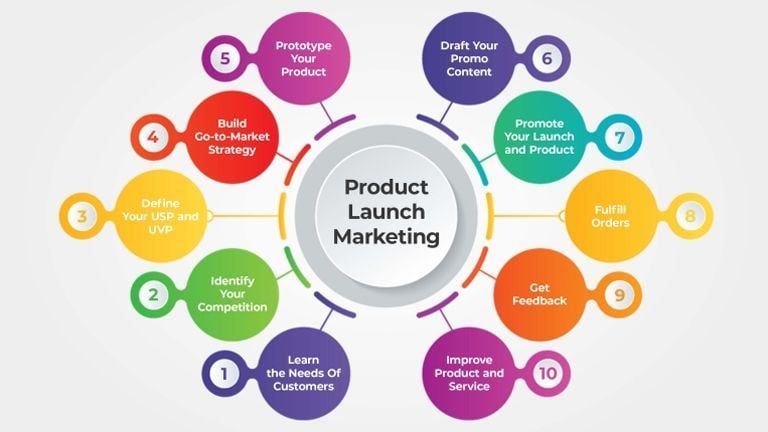Launching new products is always a risk, no matter whether a brand is a startup or a well-established company. To minimize potential downsides, it is essential to go through the preparations step-by-step for the successful introduction of the product to the market. However, there is always a danger of missing something important and losing a part of your profits as a result. Is there any way to smooth out the process as much as possible? Prepare yourself for an exciting experience.
Our 3D rendering company has extensive experience working with various product brands and creating visuals for their promotional campaigns. And a big part of the CG content we’ve made was intended for product launches. Thanks to that, we had a chance to get insights into the planning and execution of the whole process and learn from the best. Based on this knowledge, we’ve created the 10-step guide to making any product launch marketing endeavor a success. Read on!
What is a Product Launch?

A product launch is more than just putting a new item up for sale. It’s your brand’s first impression—and you only get one. This is your chance to introduce the product to the public, the press, and your potential customers. A successful launch creates buzz, drives engagement, and secures early wins in a competitive market.
A product launch marketing plan involves several key steps. This usually includes everything from market research and product development to branding, pricing, and promotional content. Some companies also run limited pre-launch campaigns or beta tests to fine-tune their messaging and product fit.
In today’s digital-first environment, visuals matter more than ever. Photoreal images, videos, and interactive 3D renderings not only grab attention but also help convey product value instantly. That’s why more brands now turn to CGI—to streamline the content creation process and get high-quality assets ready before manufacturing even starts.
Why a Product Launch Plan Matters

A product launch plan lays the foundation for a successful market introduction of new goods. Without one, even the most brilliant idea can miss its mark and struggle to connect with the right audience. A well-thought-out strategy brings clarity and direction—it helps teams stay on the same page, sets clear goals, manages resources wisely, and ensures that every marketing effort works together.
A marketing plan for a product launch also gives brands the chance to prepare for potential roadblocks, craft messaging that really resonates, and time their promotions for the biggest impact. Whether you’re launching online, in stores, or both, having a solid plan in place means you’re not just putting a product out there—you’re creating an experience that sparks interest, encourages engagement, and paves the way for long-term success.
Stages of a Product Launch

The stages of a product launch marketing campaign outline the basic steps involved in bringing a product to market successfully. Each of them plays a critical role in building momentum and resonating with its target audience.
1. Learn about the Needs Of Your Customers
Standing out from competitors is key to staying ahead, even if your brand is already established. With each new product, you must show customers you listen and evolve. Polls, interviews, and reviews can help you learn what your audience wants. Don’t forget to update them on changes you make as a part of the marketing strategy for the product launch .
2. Identify Your Competition
Analyzing competitors is a foundation of creating effective product launch strategies. Regardless of your status, monitoring market trends and emerging players supports your competitiveness. Understanding their strengths can inspire unique selling points, while their weaknesses highlight areas where your product can stand out.
3. Define Your UVP and USP
Once you understand your audience and competitors, it’s time to define your Unique Value Proposition (UVP) and Unique Selling Proposition (USP). The UVP explains what your business does in a clear, simple way—like “We offer durable, natural-material furniture.” Your USP highlights what sets each product apart, such as design, quality, or price. Together, they show customers the clear benefits of choosing your brand.
4. Build a Go-to-Market Strategy
A go-to-market strategy helps boost your product’s reach in existing or new markets. It involves defining brand messaging, generating leads, and optimizing your sales funnel for better conversions. Understanding the buyer’s journey and simplifying the sales process make for a smoother experience and a more successful product launch.
5. Prototype Your Product
Once you’ve defined your product’s key benefits and features, begin the design process. Use a prototype to test, which doesn’t have to be physical; a photorealistic 3D model works too. Share it with a focus group, gather feedback, and make improvements to minimize risks before the final step of a product launch campaign.
6. Draft Your Promo Content

Before launching your promo campaign, plan and schedule content across all marketing channels to share your content for the product launch consistently. Cover both traditional (print, outdoor ads) and digital platforms (social media, e-commerce, online ads).
Each marketing channel has specific content needs, so staying updated on trends is key. Visuals with minimal text work best across most platforms, but they must be striking to stand out. Videos, especially, have become the most effective form of content for social media.
Each channel has unique content needs, but strong visuals—especially videos—perform best. If time or budget is tight, CG services offer high-quality images and videos without the hassle of a full shoot.
7. Promote Your Product and Its Launch
Once your marketing content is ready, launch your promo campaign by showcasing the new product with key details like release date, price, features, and where to buy. Eye-catching visuals are crucial, especially for a new product, to spark interest before its release. CGI helps create stunning images and videos that highlight your product in any setting.
8. Fulfill Orders Promptly
If your promo campaign succeeds, orders will come in fast once the product launches. The next product launch step in marketing is a smooth customer journey and a positive brand impression. Offer bonuses like discounts or small gifts for first orders to show you value your loyal customers.
9. Get Feedback

Your brand can’t thrive without listening to customer feedback. Analyze reviews to learn what works and what needs improvement. Always engage with your audience by responding to comments and questions promptly. Stay connected through newsletters with offers and updates to build lasting relationships.
10. Improve Your Products and Services
Once everything is in place, use market insights and customer feedback to refine your marketing strategies. You don’t need to release new products often—updates, new designs, or remarketing can keep customers engaged. When doing a product marketing launch , be ready to repeat these steps every time.
Evaluating Product Launch Results

Evaluating the results of a product launch’s marketing efforts is crucial to understanding its impact and identifying areas for improvement. This process involves analyzing sales figures, tracking customer feedback, and reviewing the effectiveness of marketing campaigns. By examining these metrics, businesses can gauge whether the product met its goals and resonated with the target audience.
You need to evaluate operational factors like supply chain performance and customer service effectiveness during the launch phase, in addition to financial ones. Combining data with insights helps create a comprehensive view of the launch’s success.
Successful Product Launch Examples

Many companies have set benchmarks with their successful product launch marketing by combining innovation, strategic marketing, and customer understanding. Among product launch strategy examples , Apple’s launch of the iPhone changed the smartphone industry by creating massive anticipation through sleek design and groundbreaking features, paired with high-impact advertising and a seamless user experience. Similarly, Tesla’s launch of the Model 3 made electric cars more accessible to the masses, driven by strong branding and effective use of social media to engage potential buyers.
These product launch examples highlight clear messaging, timing, and customer engagement in a product launch campaign. By carefully addressing market needs and using modern marketing tools, these brands generated buzz and sustained interest long after the initial release. Studying these product launch strategies offers valuable insights for businesses aiming to make their launches impactful and memorable.
How to Effectively Manage a Product Launch

Effectively managing a product launch marketing campaign requires careful planning, clear communication, and coordination across all teams involved. Start by setting realistic goals and timelines so that everyone understands their roles and responsibilities. Regularly monitor progress and be ready to adapt your strategy based on feedback or unexpected challenges to keep the launch on track.
Additionally, maintaining strong communication with your target audience is a must-have element of the marketing strategy for a product launch . Use marketing channels to build anticipation before the launch, provide detailed product information during the release, and offer technical support afterward. Post-launch, gather customer feedback and analyze performance data to polish your approach for future launches.
Product Launch Checklist

Launching a new product successfully requires a well-structured plan that covers every stage — from market research to post-launch follow-up. A clear checklist for a product launch campaign ensures nothing is missed and helps teams stay on track for a smooth rollout.
- Understand your audience and market through research and competitor analysis;
- Define your product’s value with a clear UVP and USP;
- Create and test a prototype (or 3D visualization) to refine the product;
- Plan your marketing strategy and prepare content for key channels;
- Ensure smooth operations across sales, support, and distribution;
- Launch with clarity on product details, pricing, and availability;
- Engage and follow up with customers to gather feedback and build loyalty;
- Evaluate performance and improve your approach for future launches.
With this checklist, you can streamline your product launch process, minimize risks, and make a lasting impression on your audience. A well-executed launch not only boosts sales but also strengthens brand loyalty for the long run.
Boost Your Product Launch with Professional CGI Services

A successful product launch marketing hinges on how effectively you capture your audience’s attention—and professional CGI services are a powerful way to do just that. High-quality 3D rendering allows you to present your product in the best light before it even hits the market. Whether you need photorealistic images, animated walkthroughs, or immersive 360° views, CGI brings your concept to life and makes your marketing stand out across digital platforms.
CGI also saves time and resources compared to traditional photography and videography. You can showcase every angle, color variation, or feature of your product without the need for physical prototypes or costly setups. At CGIFurniture, we specialize in providing tailored 3D visualization solutions to help brands create buzz, engage customers, and drive pre-orders with confidence and style.
Conclusion
These key tips will help ensure your product launch marketing runs smoothly and delivers optimal results. By following them, you’ll not only reduce potential risks but also generate the desired response from your audience—maximizing engagement, impact, and profitability with every launch.
Ready to hype up the audience for your new product? Use professional 3D rendering services for product promo campaigns and make your launch ultra-successful!
What are the most effective steps in a product launch marketing strategy?
How can you tell if your product launch marketing campaign is successful?
Why is prototyping important in a product launch campaign?
What mistakes should you avoid in product launch campaigns?
Avoid skipping market research, unclear messaging, weak visuals, poor timing, and neglecting post-launch support or customer feedback.
